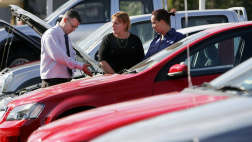In a status upgrade, car companies today say production is getting back to normal but it is still unknown how many component suppliers have been affected.
Japan is unusual in the corporate world by sourcing smaller parts predominantly from cottage industries. These can be scattered over all Japan's four main islands.
The earthquake and subsequent tsunami on March 11 specifically struck the city of Sendai in the Miyagi Prefecture, known for its electronics manufacturing. It also borders Fukushima Prefecture, location of the crippled nuclear plants, where Nissan makes its 3.5-litre V6 engines and has a supplier base.
The seven main vehicle manufacturers in Japan, and there current status, are:
HONDA
Factories: Saitama, Tochigi, Shizuoka (Hamamatsu) and Mie (east and south Honshu).
Honda suspended production at all plants and briefly reopened all except its R&D centre in Tochigi, where damage - including an employee crushed by a wall and 30 staff injured - was more severe. Honda Australia says it has now extended the production suspension and will decide on a resumption date.
MAZDA
Factories: Hiroshima (west Honshu).
"There will be delays - definitely," says Mazda Australia spokesman Steve Maciver of future supplies of vehicles to Australia. "But it's early days.We are monitoring the supply chain. We have vehicles in stock in Australia and some on water but in the longer term, I don't have an answer to how the supply situation will pan out." Mazda this week restarted production - it stopped on March 14, on partial basis. Mr Maciver says this week the factories will use up their parts inventories and complete partly-built vehicles before deciding on its supply situation.
MITSUBISHI
Factories: Nagoya, Okayama, Gifu, Kyoto, Shiga (all south Honshu).
Mitsubishi stopped production early this week. "There is no damage to the factories but some supplies have been disrupted," says Mitsubishi Australia spokesperson Lenore Fletcher. "It is still a day-to-day issue. We see no long term effect to production but the emotional effects of the tsunami are terrible."
Mitsubishi has stock in Australia.
NISSAN
Factories: Kyushu, Nagoya, Kyoto, Yokohama, Mie (south Honshu) and Iwaki (Kukushima).
Nissan's engine factory in Iwaki - in the same prefecture where Tokyo Electric Power Co. workers are battling to avert a nuclear meltdown - had no power but is getting back to production. The plant makes the V6 engine for the Murano, Maxima, 370Z and Infiniti models but Nissan says it can also get supply from a sister factory in Tennessee. Nissan Australia spokesman Jeff Fisher says all plants are operational and stocks in Australia "are good". "We ramp up stocks at the end of the March financial year," he says. "It's good for the short term but very hazy in the mid to long term - three to four months onwards." Like all other Japanese car makers, Nissan says it has yet to confirm the situation with all its suppliers.
SUBARU
Factory: Gunma Prefecture (inland central Honshu).
Subaru closed its five plants in Gunma though had no damage and no reported employee injuries. Subaru Australia spokesman David Rowley has extended its production halt until later this week. "We are confirming the situation with our suppliers and have problems with the power supply," he says. "A decision about when to restart production will be made later this week." Mr Rowley says there is sufficient stock in Australia for the short term but after that, "we're in the dark".
SUZUKI
Factories: Sagara, Kosai, Iwata (south Honshu).
Vehicle production at all factories stopped on March 15, four days after the tsunami struck north-east Honshu. Two plants restated early this week and today all plants except the Sagara engine assembly line are open. Suzuki Australia spokesperson Bridget O'Connor says the company was fortunate because its factories are further south than the tsunami zone and it directs vehicles to ports in the south and west coasts of Honshu. "Suzuki Australia has good stock levels at the moment but in three or four months, there maybe some delays," she says. "But it's really too early to tell. There maybe no effect for us." She says some parts suppliers are based in the north of the main island of Honshu but the factory has not confirmed any effects. The motorcycle division is producing at Toyokawa but has temporarily suspended assembly at Takatsuka.
TOYOTA
Factories: 12 in Nagoya (south Honshu), Kyushu, Hokkaido and Miyagi.
Vehicle production is still halted in the 15 factories but intends to restart later this week. It says parts production started last week and parts used for overseas production (KD) started on Monday, March 21.
Toyota Australia spokesman Mike Breen says the production situation changes and updates will be issued as they become available. Toyota has significant production in Australia and Thailand which are believed to be unaffected by the results of the tsunami. It opened a factory in the tsunami-affected Miyagi Prefecture at the beginning of the year which builds the Yaris. Toyota says work was stopped without incidents due to the earthquake and production was later resumed without any injuries to employees.

.jpg)











.jpg)
.jpg)

.jpg)

.jpg)



.jpg)

